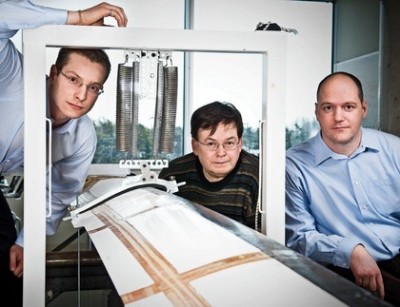Carleton recently unveiled the whirl tower facility housed at the National Research Council (NRC) campus on Montreal Road. This new facility will enable the testing of innovative new technology that increases helicopter performance, safety and comfort and improves the working and travel environment of the cockpit.
This technology, created by Carleton’s Department of Mechanical and Aerospace Engineering, changes the root boundary condition of each helicopter blade. A new, pen-sized device, called an active pitch link, reduces vibration not by dampening it, but by redistributing energy.
Nine years ago, the Rotorcraft Research Group (RRG) at Carleton University, which includes many graduate students, had a vision for a unique stiffness control concept for reducing helicopter vibrations. After many years of hard work, securing almost $1.5 million in research funding and graduating about 30 research students, the group has achieved its goal.
Kostyantyn Khomutov, a PhD Candidate and entrepreneur who is leading an Ottawa based start-up company – Smart Rotor Systems Inc. (SRS), says: “This project means a lot to me. It gives me an opportunity to work with a groundbreaking technology, meet leaders of various rotorcraft research groups and helicopter manufacturers worldwide and, most importantly, this project may change lives and create a significant impact on our society.”
Khomutov continues: “Teamwork is the number one priority in the Rotorcraft Research Group. The combination of great minds and strong group organization were the key ingredients in developing the new stiffness control concept with the active pitch link technology.”
Khomutov credits part of his success to Professors Daniel Feszty and Fred Nitzsche, cofounders of the project. “Daniel is very knowledgeable, open-minded and will spend endless hours of his own free time to help all students, the department and the university in any way he is possibly able to. Prof. Nitzsche, has also provided me with his great support and advice in helping me achieve my goals and aspirations.”
“It is very rewarding to see that the concept we have envisioned works in practice, that a back-of-a-napkin sketch can indeed be transformed to an actual technology,” said Feszty, who is also an associate professor in the Department of Mechanical and Aerospace Engineering. “The skills we have developed during this process, as well as the experimental facility we have built here, are state-of-the-art and will enable us to make original contributions to rotorcraft research on a daily basis.”
The whirl tower is the only one of its kind in Canada and is necessary to support experimental rotor programs. The tower mimics the rotating blade of a helicopter and is made up of a single carbon fibre blade and a counterweight. Centrifugal testing for this kind of technology is a necessary step before tests can begin in a wind tunnel environment. The next steps in the evolution of this technology will rely heavily on the NRC, which has the state-of-the-art infrastructure to enable wind-tunnel testing as well as to guide the product through to certification.
Thursday, May 31, 2012 in Grad Student Research, News
Share: Twitter, Facebook





